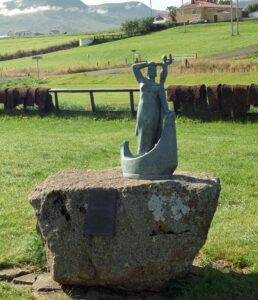
SNORRI THORFINNSSON , was the first European child born on the North American continent, son of Thorfinnar karlsefni Thordarson and his wife, Gudridr, daughter of Thorbjörn.

Public Domain
There is speculation about the birth date of Snorri Thorfinnsson. Birth years such as 1005, 1009, and 1012 have been postulated, but all sources agree that he was born between 1004 and 1013. According to the Vinland sagas, when Snorri was 3 years old, his family left Vinland because of hostilities with indigenous peoples (called Skrælingar by the settlers). The family returned to the Glaumbær farm in Seyluhreppur.
Snorri Thorfinnsson had two children; a daughter named Hallfrid, and a son named Thorgeir. Hallfrid was the mother of Thorlak Runolfsson, bishop of Skálholt in the south of Iceland. One of the descendants of Snorri’s brother Thorbjorn, Bjorn Gilsson, was also a bishop of Hólar. Thorgeir was the father of Yngvild who was the mother of Brand Sæmundarsson, bishop of Hólar. The sculptor Bertel Thorvaldsen claimed descent from Snorri Thorfinnsson in the 19th century.
The Saga of Eric the Red , supplemented by the Saga of the Greenlanders , is the main source of the few facts known about Snorri. His father, Thorfinnr, went from Iceland to Greenland. There he became interested in the new lands in North America to which the sons of Eirikr Thorvaldsson (Eric the Red) – Leifr heppni Eiriksson, Thorvaldr, and Thorsteinn – had made expeditions in the years following ad 1000. He determined to lead a colonizing expedition thither and set sail with 60 men and 5 women ( Saga of the Greenlanders ), accompanied by two other ships, some time during the years 1003–10 ( Saga of Eric the Red). Where he established his colony is not known. Newfoundland, Nova Scotia, and Massachusetts are among the many regions that have been suggested, although the likeliest spot is probably the vicinity of Cape Cod. The colony lasted for three years, and during the summers exploratory voyages were undertaken both north and south. Many scholars believe that the explorers sailed a considerable distance up the St. Lawrence River, and, according to the Saga of Eric the Red , even reached the “land of the Unipeds” of which Cartier was to be told centuries later. The peace of the colony, however, was disturbed by troubles with the aborigines of the region, although there is no agreement among historians on whether these were First Nations or Inuit. Bloody fighting broke out. Whether because of this or for some other reason, the settlement was abandoned after three years and the settlers returned to Greenland. During their stay in America, however, a son was born to Thorfinnr and Gudridr and given the name of Snorri. He was taken to Iceland by his parents two years after the colony came to an end. There he lived out his life, but the date of his death is unknown. However, it is known that a “great and goodly lineage” sprang from him, including several of the early bishops of Iceland.
In the 13th century texts Snorri Thorfinnsson and Snorri Thorrgrimsson are considered the two main figures responsible for the early Christianisation of Iceland. Consequently, they were portrayed by various writers of the 13th and 14th century as “Christian chieftain models”.[3] According to Grœnlendinga saga, Snorri had built the first church of Glaumbaer, which would later increase Christian influence in the area. His descendants became the first Bishops of Iceland, and published the first Christian Code of Iceland.[11]
 The word is most likely related to the Old Norse word skrá, meaning “dried skin”, in reference to the animal pelts worn by the Inuit. William Thalbitzer (1932: 14) speculated that skræling might have been derived from the Old Norse verb skrækja, meaning “bawl, shout, or yell”. In modern Icelandic, skrælingi means “barbarian“, whereas the Danish descendant, skrælling, means “weakling”.
The word is most likely related to the Old Norse word skrá, meaning “dried skin”, in reference to the animal pelts worn by the Inuit. William Thalbitzer (1932: 14) speculated that skræling might have been derived from the Old Norse verb skrækja, meaning “bawl, shout, or yell”. In modern Icelandic, skrælingi means “barbarian“, whereas the Danish descendant, skrælling, means “weakling”.
The term is thought to have first been used by Ari Thorgilsson in his work Íslendingabók, also called The Book of the Icelanders, written well after the period in which Norse explorers made their first contacts with indigenous Americans. By the time these sources were recorded, skræling was the common term Norse Greenlanders used for the Thule people, the ancestors to the modern Inuit. The Thule first arrived in Greenland from the North American mainland in the 13th century and were thereafter in contact with the Greenlanders. The Greenlanders’ Saga and the Saga of Erik the Red, which were written in the 13th century, use this same term for the people of the area known as Vinland whom the Norse met in the early 11th century. The word subsequently became well known, and has been used in the English language since the 18th century.
“Kalaallit“, the name of the largest ethnic group of Greenlandic Inuit, is likely derived from skræling. In 1750, Paul Egede mentions that the Inuit used “Inuit” among themselves, but used Kalaalit when speaking to non-Inuit, stating that this was the term used by Norse settlers.